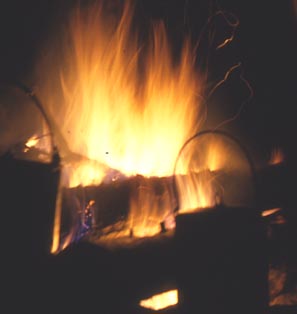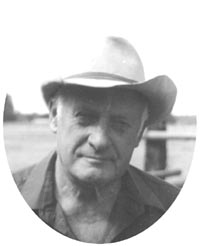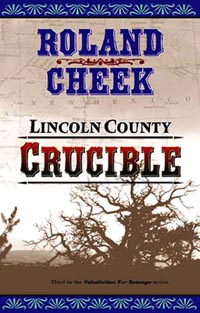a weblog sharing info on outdoor skills and campfire musing by a guy who spends a bunch of time in pursuit of both
CULTURE
WHERE -
TALES ARE TOLD OF
Welcome to Roland Cheek's Weblog
Roland is a gifted writer with a knack for clarifying reality. Looking forward to more of his wisdom
- Carl Hanner e-mail
While still in high school, fifty-some years ago, the rumor was that a particularly good-looking girl smoked marijuana. I made a date with her because I wanted to push the envelope and learn more. She didn't smoke any weed that night and, in fact, had me take her home by 10pm (so, I later discovered, she could entertain her evening's 2nd date). The upshot of all the above? A half-century later, I still don't know what marijuana smells like. Nor have I discovered a use for any other drug, perhaps because the addiction I acquired was a love for the outdoors. Maybe I'm lucky on so long-ago evening that the girl I pursued had a hotter date.
To acess Roland's weblog and column archives
Tip o' the Day
I've slipped in and out of my saddle a few thousand times, so I know it fits. But like most other horsemen, I don't know how to help anyone else find just the right saddle to fit them.
So to learn more about picking a saddle that fits, I asked a fellow whose advice I've respected enormously for well over forty years. Larry Gleason is a retired Ronan saddlemaker who also guided a few of my hunters during years I spent leading others to adventure in the Bob Marshall Wilderness.
"Find a saddle that fits, huh? Larry said. "Maybe that depends on how much a person plans to use it and what for."
I asked Larry to explain.
"There are three kinds of seats: cantle, center seat, and level seat. In a cantle seat, the front is high and it's deep back by the cantle. Center seats slope to the middle from both pommel and cantle. They're probably best for most people, expecially trail riders. Level seats are mostly for cutting horses, used with forward stirrups."
"How about the old style?" I asked. "High horn and cantle?"
"Again, that might depend on what you're doing with it. A person can get hurt with a tall horn or high cantle if their horse begins plunging around. Tall horns are usually double-dally horns that are for roping and team roping. Not much good for anything else. All a rider needs is a horn that's tall enough to get a good grip on."
"How about a high versus low cantle?"
"Should be high enough to come up on the buns, but not so high you can't swing in and out easy. Again, a shovel cantle can be a dangerous thing if you're straddling a rank horse. I'd say not over a 4-inch cantle."
"What about seat size?" I asked.
"Trees are measured from the base of the horn to the top of the cantle. But how comfortable you sit will also depend on location of swells. If swells are low, it'll spread your legs enough to be uncomfortable. Higher swells might allow you to slip easily into a smaller tree size.
I asked about stirrups?
"Most people say proper riding posture should be to sit erect and comfortable. You should be able to look down past your knees and see the tips of your toes, with the heel lower than the toe. By riding in this manner, most folks will have better leg contact with their horse."
Larry's advice is to buy only good quality saddles with a rawhide or fiberglass tree.
Knowing what the answer would be, I still asked about padded seats. The old saddlemaker stared steadily at me for several moments, then said, "Next quesion."
Thanks, Jane. I'm really enjoying Roland's stories -- this one about three travelers in the Bob with a wheelchair was amazing! / email from Fran Brinkley
* * *
Love your books. They are so much better than Louis L'Amour's / email from Josh Richmond
* * *
I found it. I liked it. And I sent a copy to Major Mitchell / email from Pat Nipper
SAME RESULT - DIFFERENT APPROACH
I'm not what you would call an ordinary, run-o'-the-mill techno-freak. As an example, I was years into the outfitting business before bothering to put a telephone number on a promotional brochure. I didn't rush into that brochure either. Both it and the phone number (if you must know) were prompted by our family's need to eat.
Throughout my career guiding others to wilderness adventure, I had a tendency to sneer at potential clients who questioned whether they could risk disappearing for a week or so without outside contact. In fact, my stock reply to a high-powered businessman explaining his need to be in touch with office or factory on a day-by-day basis was, "Maybe the Bob Marshall ain't for everybody."
Thank God I retired from guiding others before the advent of cellular or satellite technology. Imagine my frenetic response if a hunter's porto-phone began ringing just as I'd called a herd bull within shooting range!
Naturally, back in the 60s and 70s I reserved my most biting sarcasm for anyone suggesting the microchip and its resultant computer technology would prove as convulsive as yesterday's industrial revolution.
Was I ever wrong!
It's hard to teach an old dog new tricks; harder still for an old dog to learn them on his own. But I'm typing these words into a computer and reading them on a screen. Both are hooked to a hard drive containing an overwhelming array of programs about which I'm totally illiterate, save one. Ask me about ROMs and RAMs and I'll retreat into an old man's recollections of bull elk standing on skylines.
But both my wife Jane and her husband each have our own personal computers as a necessity. I'm word processing on mine; she does bookkeeping and maintains a mail list on hers. Still, the world grows apace and we must grow with it. As our tiny book publishing business developed, we found we must get into page design. Neither of our computers were capable, so a third computer squats on a table accessible to both of us. Then she found she needed a design machine for her very own use. Those design machines began as second-hand dinosaurs, but they were capable of doing page designs beyond our wildest dreams.
Learning to use the new Apple computers and their design programs was tough for a couple of cast-offs from the Great Depression era who, during our early years, saw little need for anything more than a quill pen and an abacus. Lord, was it frustrating! Jane lost a critical file on her new computer, triggering a family argument. But she later found it and we kissed and made up (so I broke into her office during the middle of the night and hid a couple more files so we could kiss again).
From homes across America, the relentless eye of computer screens stares unwinking across generations, exacerbating hypertensions and blood sugar levels. From kitchen counters to the tops of bedroom dressers, the microchip revolution is alive and well. Farmers, ranchers, housewives, and schoolkids, it's all the same; if I had stock in network television I'd be fore dumping it to get into computers.
At least I should've done so back in my quill pen days.
Sometimes one must dance to music not of his making. Personal computers fit that category for me. After just a quarter of a century, their presence has so revolutionized the world I knew that I had to get in or get out.
We can accept that change as something exciting and challenging. or we can, as I once did, go into a denial that hurts only me. Either way makes no difference to the outcome.
Except to me.
Roland Cheek wrote a syndicated outdoors column (Wild Trails and Tall Tales) for 21 years. The column was carried in 17 daily and weekly newspapers in two states. In addition, he scripted and broadcast a daily radio show (Trails to Outdoor Adventure) that aired on 75 stations from the Atlantic seaboard to the Pacific Ocean. He's also written upwards of 200 magazine articles and 12 fiction and nonfiction books. For more on Roland, visit:
www.rolandcheek.com
Recent Weblogs
Tuesday, March 24, 2009
for more info about these and other Roland Cheek books
There's a bunch of specific info about Roland's books, columns, archives and radio programs. By clicking on the button to the right, or below left, one can see Roland's synopsis of each book, read reviews, and even access the first chapter of each of his titles. With Roland's books, there's no reason to buy a "pig in a poke."
for detailed info about each of Roland's books
Read Reviews
Read their first chapters
For interested educators, this weblog is especially applicable for use in outdoor / nature classes, as well as for journalism students.
Roland, of course, visits schools. For more information on his program alternatives, go to:
Books 2 & 3 are set amid New Mexico's violent Lincoln County War
Book four in the Valediction For Revenge series, Gunnar's Mine, is set in Colorado mining country, as is the sixth and final book in the series, The Silver Yoke
Book five in the series, Crisis On the Stinkingwater, is set around present-day Cody, in what is now called Wyoming's Shoshone River Country
I knew you were a good writer, but I never before put you in the class of Michener and Clancy. You spin a good yarn and don't let it drop for a minute. You handle dialogue extremely well, and the action scenes are outstanding. You have no reason to venture so carefully into the world of novelists.
- Jack Oliver / Pittsburgh, PA
NEXT WEEK:
FIGHTING OFF DANGEROUS CREATURES
www.campfireculture.com
to send this weblog to a friend
to tell Roland what you think of his Campfire Culture weblog
source links for additional info
to visit Roland's newspaper columns and weblog archives








